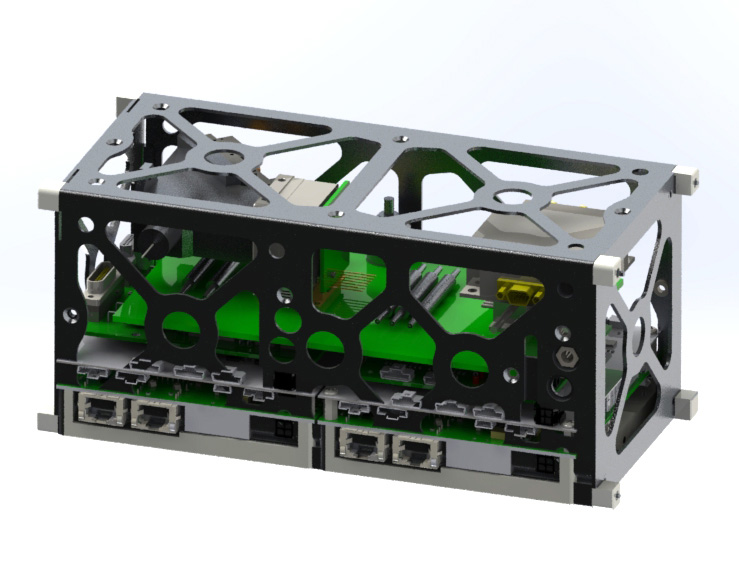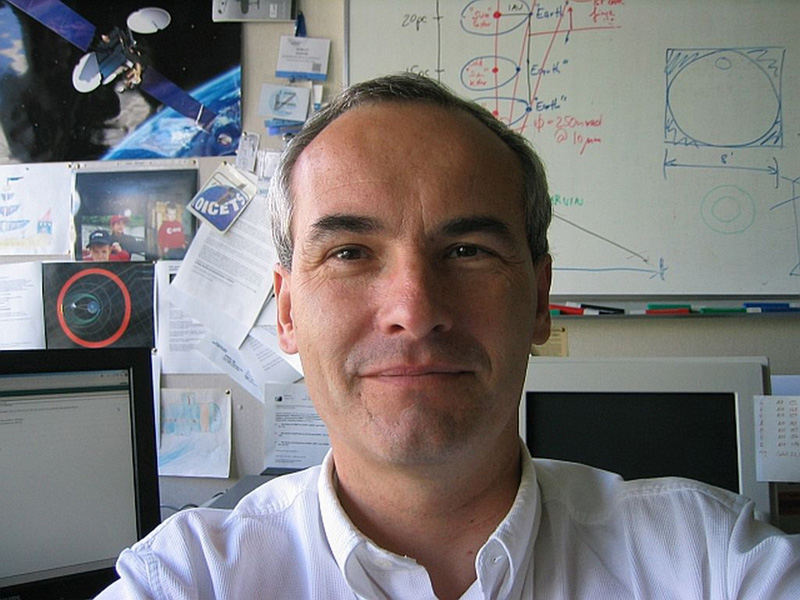Free Space Optical Communication (FSOC) technology continues to occupy a central position in the ongoing development of next-generation computer networking and telecommunications systems. According to Tim Kane, Professor of Electrical Engineering at Pennsylvania State University, the key recent trends and themes in the development of FSOC technology over the past year or so have been efforts focused on "moving out of the lab and into practice." In Kane's view, the RF spectrum is "limited and already crowded, and there's only going to be more demand as 5G expands and the Internet-of-Things takes off."
"Free-space optical communications will never replace RF, of course, but will serve in a complimentary position, especially in RF-crowded or denied environments. This will be enabled by continuing improvements in FSO communication rates, reliability and adaptive network design," he says.
At SPIE Photonics West, Kane presented the results of his teams' work on acquisition, tracking, and pointing for reconfigurable free space optical communication systems in RF-challenged environments. As he explains, some of the teams' current work applies real-time image recognition and tracking to the estimation of relative position and heading between optical transceivers in the 10s of meters range.
"The primary challenge is in reducing latency — that is, how long it takes to lock-on and communicate, while retaining reliability. We are beginning to explore applications in vehicle-to-everything (V2X) communication, robotic navigation, as well as undersea. In the future, satellite-to-satellite comms is an exciting and crucial area of interest," he says.
As part of this work, Kane's team has custom built its own transceivers, supplemented with image tracking using COTS (Commercial-Off-the Shelf) components and algorithm development, as well as MEMS-based fine-tuned beam steering mirror arrays.
Looking ahead, Kane also predicts a number of key innovations and trends in the development of free-space optics communication systems over the coming few years. In particular, he argues that, at the most basic level, several key innovations must include the development of high-precision low-latency pointing, acquisition and tracking systems and low-cost, high-reliability optical transceivers, as well as advanced modulation and coding schemes and advanced FSO network topologies.
"The latter two, especially, are necessary for improved capabilities in turbid environments — think haze or fog — as well as intelligently integrating into existing RF networks," he adds.
Crowded space
Elsewhere, Jim McNally, Vice President for Strategic Development at Applied Technology Associates (ATA), observes that the key recent developments in this space have been advances in solid state lasers and commercial fiber-optic communications hardware, as well as the development of lower cost, high-speed radhard ADCs, DACs, and rad-hard FPGAs.
"The community is developing SW-based modems and the continued development of these over the past few years has really been enabling for small, highly-capable FSOs. Market pull has driven the industry to mature the needed technologies for widespread implementation of FSOC. There are planned large LEO constellations requiring communications links between each platform," he says.

Rendering of the SOCOM CubeSat from the team at ATA. Image: ATA.
Meanwhile, McNally's colleague, John Garnham, reveals that the issues caused by "spectrum contention" as the RF communications spectrum continues to get more and more crowded, as well as the "insatiable demand from consumers for more and more bandwidth," are also driving the industry towards FSOC.
Both Garnham and McNally have recently been engaged in work on the use of position and time information via FSOC. As part of this work, ATA has employed advanced platform stabilization technologies and detection techniques for its cutting edge FSOC terminals — as well as advanced laser beam stabilization and tracking technologies that permit small size, weight and power terminals to be employed.
McNally predicts two different major trends. The first is small, low-cost crosslinks between satellites (or UAVs) for moderate data transfer and command and control, with a large emphasis on small and low-cost, which will require the implementation of photonic integrated circuit technologies for the terminals and overcoming challenges relating to the need to develop rad-hard optical amplifiers. The second is large, very high throughput FSO links to act as major feeder links for geosynchronous Communications satellites.
"The challenges for the wide implementation of FSOC terminals for GEO backhaul communications constellations will be to drive the costs of the terminals down," adds McNally.
Meanwhile, Zoran Sodnik, Head of the Opto-Electronics Section: TEC-MME at the European Space Agency (ESA), reveals that the main recent trends in FSOC, at least at ESA, are: cost efficient optical terminals for inter-satellite communication in constellations, small direct-to-ground optical communication terminals for CubeSats, optical feeder-link technologies for terabit data rates, quantum key distribution from LEO (and GEO), cost-efficient optical ground stations and networks, PICs and technologies, standardization of optical communication technologies.
"My section deals with the development of optical communication and quantum key distribution systems and their testing and commissioning once launched. To do so we run ESA's optical ground station in Tenerife," says Sodnik. "The European Data Relay System (EDRS) also runs the only commercial optical inter-satellite link worldwide."

Zoran Sodnik in his office at the European Space Agency. Credit: ESA
Generally speaking, Sodnik believes that space-based optical communication is "ideal" because of the absence of clouds and atmospheric turbulence and, in order to exploit these advantages, EDRS is using a coherent modulation scheme at a wavelength of 1064 nm. ESA is also developing optical communication technologies in the 1550 nm wavelength spectral band.
Looking ahead, Sodnik predicts that the key trends moving forward are "clearly the development of reliable links through atmospheric turbulence and efficient switch over between optical ground stations in case one is clouded over."
Elsewhere, Professor Manijeh Razeghi, Director of the Center for Quantum Devices (CQD) at Northwestern University, observes that one of the benefits of research in free-space communications is the fact there are "so many ways to tackle the same problem." From her perspective, current themes in the development of free space optics technology are split into two key foci: the communications system and the solid-state engineering behind the laser and detector.
"The work on communication systems seeks to maximize symbol rate in a given frequency window and apply high order modulation formats. The optics work is focused on atmospheric attenuation, spatial multiplexing, and the potential of MWIR and LWIR frequencies," she says.
Some of the other trends Razeghi has noticed are spatial multiplexing, MIMO systems to mitigate atmospheric effects, and a shift in focus "towards novel modulation techniques rather than increasing system speeds."
In Razeghi's view, the uniqueness of the development of highspeed free-space optical communications stems from "a desire to minimize the atmospheric loss due to carbon dioxide absorption," which "can be done by shifting the operating wavelength from the 1.55 μm to 1.6 μm window, where the majority of commercial FSOC systems operate, to the mid-infrared." In an effort to achieve this, she and her team have focused on the development of high-speed free-space optical communications based on quantum cascade lasers and type-II superlattice detectors.
Team member Emily Dial, an undergraduate student at Northwestern University, explains, "Quantum cascade lasers are a promising technology with the flexibility for application in numerous FSOC system types. They offer room-temperature continuous wave operation, high output power, intrinsic robustness against optical feedback, and large modulation bandwidth. Type-II superlattice materials, commonly used for imaging, are also capable of being effective detectors for FSOC systems."
"Mercury cadmium telluride detectors are currently the prevailing technology; while promising, they have large dark currents and require cooling. T2SL detectors have lower dark current and can operate uncooled. The design, fabrication, and implementation of these innovative quantum devices has allowed the CQD to produce high-speed MWIR free-space communications," she adds.
Infrared advantage
In Razeghi's view, the uniqueness of this system is that it operates in the mid-infrared, taking advantage of the atmospheric window, where scattering due to carbon dioxide is decreased — a feat the team accomplishes by utilizing the CQD's quantum cascade lasers and type-II superlattice photodetectors. An FPGA also receives a data stream and encodes it with Manchester encryption, before sending the data to a PCB laser driver that directly modulates the QCL, transmitting a continuous bit stream. A single aspheric lens is then used to collimate the QCL beam. After passing through a Fresnel lens atop a T2SL photodetector, the data is decoded via FPGA and sent to a computer for viewing. "FSOC technologies are useful for their high security, high bandwidth, and portability. For example, a university or business located in a metropolitan area that desires a secure, high-speed communication link between buildings may employ an FSOC system, as it requires much less infrastructure to set up than a fiber optic link at comparative speeds," says team member Stephen Johnson, also an student at Northwestern.
"The security aspect of FSOC is especially useful for military applications, for, due to the point-to-point nature of the technology, the beam cannot be intercepted without a loss of power at the receiving end. And as autonomous vehicles and satellite communications increase in ubiquity, the need to communicate rapidly through free space creates a need for robust FSOC technologies," he adds.
Looking ahead, Razeghi points to "many exciting areas of research" in the field of free-space communications, with potential innovations tending to fall into either increasing the speed and/or the distance of the FSOC link. As RF and fiber communication speeds increase, in parallel, she reveals that FSOC technologists are also beginning to push toward terahertz operation, a feat he points out will require "novel encoding schemes, modulation techniques, and high-speed nanotechnologies."
Andrew Williams is a freelance writer in Cardiff, UK. This article was originally published in the 2020 Photonics West Show Daily.
Enjoy this article?
Get similar news in your inbox | |